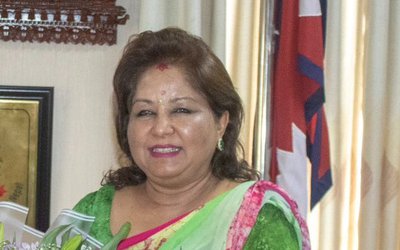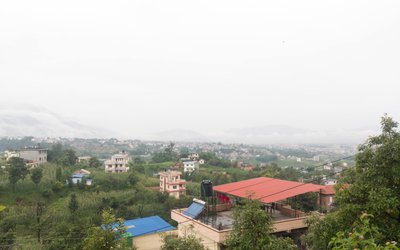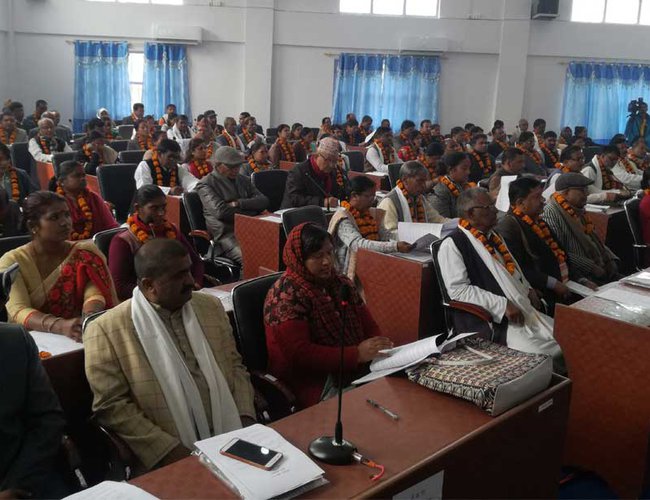
The first and foremost step for the newly elected chief minister of Province 3, Dor Mani Paudel, was his inspection trip to Mugling-Narayanghat portion of a road, where construction was going on.
During his visit, Chief Minister Paudel not only directed the contractors and officials but issued an urgent order saying that he will take the necessary action against those who failed to complete the task in time.
The road is a part of the national highway and lies under the jurisdiction of the central government. However, the road is in Province 3, as an interstate road. Amid this confusion, Chief Minister Paudel thought that the road was under the jurisdiction of his province.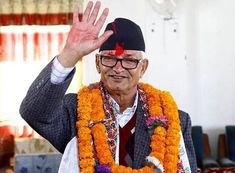
Similarly, chief minister of Province 2, Mohammad Lal Babu Raut summoned the provincial security meeting by inviting Nepal Army, Nepal Police, Armed Police and Intelligence in his office and directed them to maintain the law and order in the province.
Chief Minister of Province 5 Shanker Prasad Pokharel started his office by visiting the Lumbini Area and directing the officials of Lumbini Development Trust and other officials regarding its development.
Chief Minister of Province No 2 Raut even wrote an open letter to Prime Minister K.P. Sharma Oli for his support to provide necessary financial and institutional support to make his province functional. He complained over the high-handedness of central officials in his work.
These three incidents show how Nepal’s new practice of federalism is heading. If the parties concerned are unable to address the confusion in time, it is likely to create a chaos in the future.
Constitutional Provision
Although the Constitution of Nepal 2015 has defined the role and responsibilities of federation, state and local levels, there is confusion in some of the constitutional provisions.
Article 231 to 237 of Part 20 of the Constitution of Nepal has clearly stated the interrelations between federation, state and local level. Similarly, schedule 5,6,7,8 and 9 have listed the powers of federation, state and local level.
The schedule 5 states the list of matters related to federal power and 6 states the list of state power and 7 lists concurrent powers of federation and state. Similarly, schedule 8 states list of local level power and schedule 9 states the list of concurrent powers of federation, state and local level.
Interestingly, federation, state, and local levels have common power on archeology and ancient monument and museum. Similarly, state police administration and peace and order and interstate highway fall under the list of state power. Province too has power on sites of archaeological importance and ancient monuments and road.
Federal Work Procedure
Although the federal cabinet has already approved the detailed work procedure as per the schedule of the constitution, it seems that the document is yet to reach state and local level.
As there are so many articles and clauses with contradictory provisions, chief ministers like Paudel, Pokharel and Raut may collide with the federation and local level on exercising their powers.
The Narayanghat-Mugling portion of road purely lies within Province 3 from its start to end. However, it is a part of Gorha-Mugling Narayanghat Highway linking two states 3 and 4 with the federation. It is natural for chief minister Poudel to have confusion. As a large portion the highway also passes through Bharatpur Metropolitan City, BMC may claim it is under its jurisdiction.
Chief Minister Pokharel’s visit to Lumbini was nothing wrong as the archeological site falls under federation, state and local level. The question remains about the single power that is competent to handle the issue.
Similarly, state-level security and law and order issues fall under the state government. Chief Minister Raut’s understanding about summoning the meeting too has a valid point.
As Nepal is in just the initial stage of federal practice, this kind of confusion on an exercise of power is natural. However, steps must be taken to correct and set the precedents for the future.
“I am aware of the role of the chief minister. Since the federation is yet to declare which road is under federation and which road is under state, there is definitely a certain confusion,” chief minister Paudel told New Spotlight.
Nepal’s Own Way of Autonomy
Nepal is an ancient state and it does not have any direct historical or modern link with the federal countries like Spain, South Africa, Switzerland or Ethiopia, West Germany, Canada or the United States.
However, Nepal has its own system, which prevailed till 1965. The status of Kings was stripped off just after 2008. This showed Nepal has a system of autonomous rule in centralized administration.
As a multi-ethnic, multicultural and multi-religious country with about 30 million population, Nepal has its own long practice of traditional autonomous system. Even after the integration of Nepal as one nation, Nepali rulers allowed a certain geographical region to exercise the autonomy.
Eastern part of Nepal was given full autonomy under the Kipat system. Similarly, the state also accepted the role of local kings giving them local authority even after annexation.
There existed almost dozens of local kings across Nepal. After promulgation of an act in 1962, King Mahendra stripped a title from most of them. Some principalities even enjoyed complete internal autonomy till 1965 like Mustang, Bajhang, and Thalahare.
Under a proclamation of King, Mustang, Salyan, Jumla, Doti, and Bajhang enjoyed the state privilege and title of King.
Mustang was once an independent kingdom, although closely tied to language and culture to Tibet. From the 15th century to the 17th century, its strategic location granted Mustang control over the trade between the Himalayas and India. At the end of the 18th century, the kingdom was annexed by Nepal and became a dependency of the Kingdom of Nepal since 1795.
Though still recognized by many Mustang residents, the monarchy ceased to exist on October 7, 2008, by order of the Government of Nepal. The last official and later unofficial king (raja or gyelpo) were Jigme Dorje Palbar Bista (1930–2016).
No One-Size-Fits-All
“There is no one-size-fits-all. Each country has its own distinctive historical configuration of power and authority,” said Dr. Paul Hutchcroft, of Australian National University. One example is coming together of federalism (bringing together previously existing units) versus holding together federalism (large or diverse countries seeking to respond to pressures for autonomy or secession.)
Understanding the nature of the underlying political institutions, especially the two critical institutions of the bureaucracy and political parties are key. If both are weak, whatever is constructed may end up being unstable. It is a bit like constructing a house on shifting sands.
“Another important aspect is: what is the underlying capacity of an administrative system, the bureaucracy, and political system through political parties if they are able to aggregate social demands and present coherent policies in the public sphere,” said Dr. Paul Hutchcroft, Australian National University.
“Governance is a major component for the success of any system,” said Dr. Gambhir Bhatta, advisor, SDCC, and concurrently, chief of governance thematic group, ADB.
“Nepal is going through a typical transformation from unitary to full federalism. There are opportunities as well as challenges. We have started federal practices without adequate resources and institutional setup. The challenges again are service delivery and fulfilling high aspirations of people with limited resources. Governance at a provincial level and local level is another challenge,” said former vice chairman of National Planning Commission Dr. Swarnim Wagle, addressing National Conference on Urban Governance.
Organized by the Asia Foundation and Asian Development Bank, the two-day national workshop concluded debating various issues of urban governance including federalism, reforms in the context of centralization, decentralization, and dynamics of change. Managing 753 local levels and 7 provinces is economically challenging.
“Our federalism evolved in our own context and soil and it will be different than the rest of the world. We are in the transition and we need coordination and cooperation between state, province and local levels. Due to lack of idea, we have already seen some lapses in their functioning. All the leaders need to be cautious about their constitutional rights and obligations,” said Kishore Thapa, leader of Sajha-Bibekshil Party.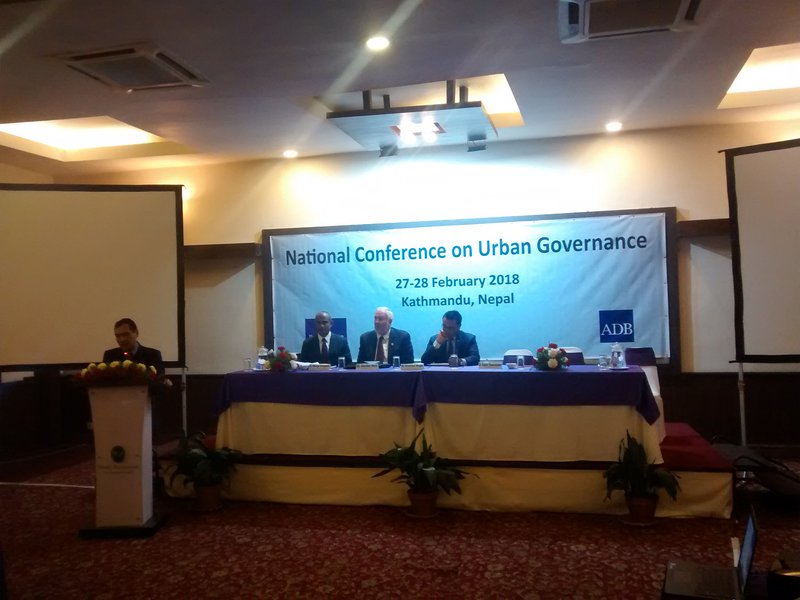
“National party led by CPN-UML and Maoist Center has a thumping majority in the six provinces along with the center. This is a good sign for a successful transition. If the government functions for the first five years, they will likely establish state-level infrastructure,” said Sushil Gyawali, urban planner and former CEO of NRA. “Although we can see certain lapses in an exercise of authority, the good sign is that they are functioning.”
Bharat Bahadur Khadka, a member of No 7 state province, holds the view that states need to be self-sufficient to function properly. “Our province has already issued a seven-point declaration to mobilize the local resources to be self-sufficient,” said MP Khadka. “Provinces should be given full power to generate resources in their own state areas.”
Human Rights Activist Srijana Pokharel questioned whom Nepal’s federalism was for. “If federalism is for the people, they should develop an effective delivery mechanism. If it is just for leaders, it will just rectify corruption.”
New Experiment
Nepal’s journey to the modern form of devolution of power and the constitutional government started after 1951. The first experiment of local devolution of power was made through the establishment of agriculture extension office in the district under the support from the United States back in 1955. This institution later took place of a grassroots level institution or current rural municipality.
In between 1951 and 1958, Nepal was restructured in view of the new requirements for administration, development and control rather than self-government or autonomy.
After the abolition local Kings and autonomy system, Nepal was divided into 35 districts for the purpose of administrative reorganization. In 1956, the home administration was restructured and the country was divided into seven regions,32 districts, and 74 sub-districts.
Following the takeover of King Mahendra in 1961, the country was restructured into 14 zones and 75 districts. A systemic decentralization kicked off after the promulgation of 1962 constitution.
In 1973, Nepal was further restructured into four development regions Eastern, Central, Western and Far-western in view of balanced and integrated development needs. In 1981, four development regions were made into five, splitting the far-western region. Although region and zone are abolished, the district created in 1962 is still intact. Out of seven provinces, five head of regional offices is now assigned to work as the chief secretary of state.
Although Nepal started decentralization since 1960, actual decentralization started after the promulgation of Local Self Governance Act in 1999. This is the first act which statutorily recognized the role of local self-governance and devolution to make local bodies more responsive and accountable. However, this act ended prematurely or without its full implementation.
The current form of federal restructuring of the state is a recent one. Started with the first amendment of the interim constitution in 2006, Nepal entered into federal practice theoretically.
After the promulgation of the new constitution in 2015, the present restructuring of the state started. Along with local bodies, the new set of autonomy is in the practice now under the state.
Nobody knows what kind of federalism Nepal is going to practice and what shape it will take.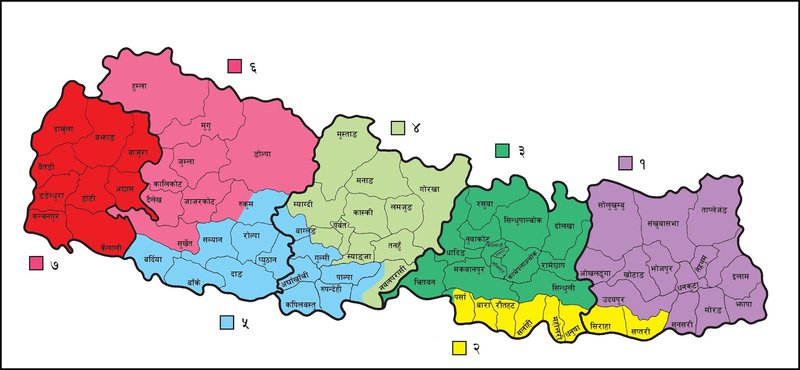
New Structure
With the availability of local infrastructure developed in the period of last six decades, the new state started the process of institution building. At a time when the entire state has already expanded the cabinet, they are yet to get human resources to run the offices. Out of seven states, six states have CPN-UML coalition government as in the center. However, the state 2 has Madheshi leading the government.
As the center is yet to provide necessary human resources, chief minister of state 2 Mohammad Lalbabu Raut has sent an open letter to Prime Minister KP Sharma Oli seeking administrative help.
Chief Minister Raut has written to Prime Minister Oli complaining that he did not receive help from the federal administration. In the letter, Raut has urged PM Oli to provide him administrative help.
“This province has a different type of security challenge. While trying to make proper arrangements for security of chief minister, ministers and important officials of the province, the federal administration did not cooperate,” the letter reads.
“Employees deployed by the central government have not reported to the province yet. Severe lack of human resources has crippled administrative works for long,” the letter reads, urging PM Oli to help the provincial government in any way possible.
Despite decades of exercise for federal Nepal, the recent incidents show that Nepal has not prepared much for the implementation of the federal government in Nepal.
“A decade ago, Nepal’s political parties agreed to change the country’s unitary system of government to a federal system. This change was seen by many as a panacea to help address the country’s problems of governing such variegated demography, society, and geography. Two years after Nepal’s 2015 Constitution established federalism, the country is now challenged with how to operationalize the federal structure — with intense controversy surrounding the way in which revenue will be shared between local and national levels emerging as the latest fault line,” wrote Iain Payne and Binayak Basnyat in their article in 2017, July.
“In Nepal’s federal structure, power has been divided into three tiers of government, each of which has autonomy to raise and spend revenue. However, the legislative and regulatory framework for the assignment of revenue was not put in place prior to local government elections, resulting now in a confusing paralysis of claims and counterclaims emanating from old and emergent power centers. Consequently, continued progress in the successful implementation of the federal provisions of the 2015 Constitution is in jeopardy.”
Although the Natural Resources and Fiscal Commission Act and the Inter-Governmental Fiscal Transfer Acts have clarified the certain level of uncertainty, there is still a long way to go before everything becomes clear. These two acts help in the management of public finance in the federal structure, overseeing revenue distribution among the three tiers of government.
Although the spirit of the constitution is to devolve the resources to the state and local level, these acts give the central government an increased share of national revenue collection, at the expense of local governments.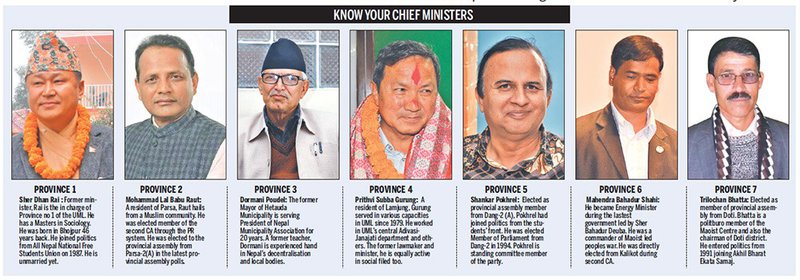
According to the acts, the central government will retain 85 percent of taxes collected from sectors like mountaineering, hydropower, forest, mines, minerals, and other natural resources, leaving only 5 percent for local-level governments and 10 percent for provincial governments.
As the new Constitution envisages local and provincial governments as meaningful contributors to and drivers of the local planning process, the center is yet to start the process to equip second and third tier to prepare their own plan.
Although Nepal started the debate on federalism as a more radical model, even talking about the right to secessionists, it ended with a relatively fiscally centralized system.
Along with security and development, the central government retains all major revenue sources, including individual and corporate income taxes, and VAT. Provincial and local governments are only assigned a limited number of comparatively low-yielding revenue sources like property and vehicle taxes.
The current directives, regulations, and acts promulgated by the government show centralized tendency of people in the center.
“At this time, it is also important to maintain perspectives and situate elections in the larger agenda of governance reform in Nepal. We must take fresh account of both the distribution of power and the tension between institutions of representation and institutions of restraint in conditioning state and non-state actions toward more accountability, transparency, and justice. In absence of this accounting, the impunity of the past several years will remain entrenched and become distributed across Nepali society. Therefore, the tortuous transition toward democratic consolidation in a federal structure and the building up of new institutions must be understood as deep deficits that need to be addressed in both politics as well as the rule of law. Much remains to be done; let us embrace the task,” writes George Vaurghese, The Asia Foundation’s country representative in Nepal.
Although Nepal has entered into a new phase of political transformation with the devolution of power, challenges before Nepal’s transformation from a unitary to federal state remain to be how the power is devolved and how governance works.

Keshab Poudel
Poudel is the editor of New Spotlight Magazine.
- HELVETAS NEPAL’S RIVERBED FARMING: Shift From Overseas To Local Farming
- Jul 26, 2024
- POLITICAL SCENARIO : K.P. Sharma Oli's Resurgence
- Jul 21, 2024
- UNDP/MinErgy: An Inventive Approach To Clean Brick Kiln
- Jul 19, 2024
- HELVETAS NEPAL: Nutrition Through Riverbed Farming
- Jul 18, 2024
- NOU Opens To All: Dr. Shilu Manandhar Bajracharya, Vice Chancellor
- Jul 15, 2024






